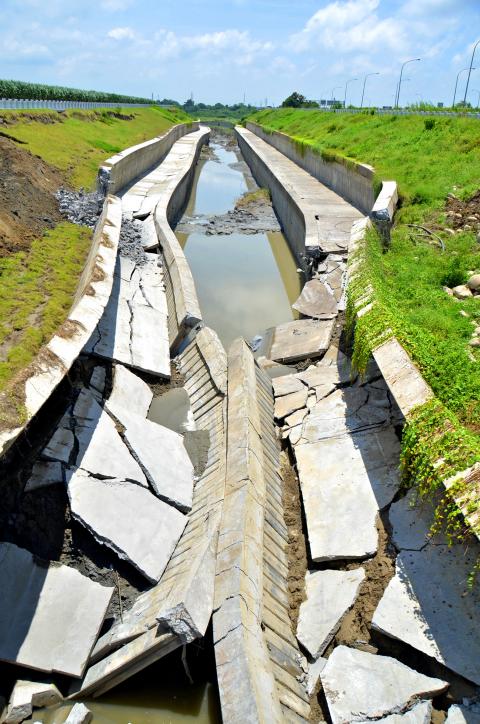A 170m stretch of the Gangweigou River (港尾溝溪) flood-diversion channel in Greater Tainan collapsed in the early hours of Friday after torrential rains that hit the south on Tuesday, prompting concerns over the sturdiness of the structure, which had been inaugurated three weeks ago.
The Gangweigou diversion channel, constructed by the Ministry of Economic Affairs’ Water Resources Agency, spans 3.8km and cost about NT$1.5 billion (US$49.9 million). The project was launched in March 2012 and was only recently completed, with an inauguration ceremony held on July 26 this year.
The Water Resources Agency’s Sixth River Management Office yesterday said it would complete emergency repair tasks in the ruptured area before Wednesday.

Photo: Wu Chun-feng, Taipei Times
Sixth River Management Office director Tsai Tsung-hsien (蔡宗憲) said the Gangweigou diversion channel was designed to withstand 175 tonnes of water per second, as seen in once-a-generation events. However, the rainwater in the channel on Tuesday flowed as rapidly as 250 tonnes per second, resulting in structural damage, he said.
Unconvinced, Greater Tainan City Councilor Wang Ting-yu (王定宇) of the Democratic Progressive Party said the flood-diversion channel was “the most expensive ‘tofu-dreg’ project in history,” adding that it could endanger the nearby National Sun Yat-sen Freeway (Freeway No. 1).
He also called into question the soundness of the construction materials used in the channel, alleging that contractors may have cut corners during construction and demanding that authorities investigate.

Tsai responded to Wang’s suspicions by saying that the flood-diversion channel was built of concrete sheet piles, which are bound together by a cap beam.
He also denied that the facility would pose a threat to the nearby freeway, saying there is about 10m of space between the two.
Meanwhile, Greater Tainan Mayor William Lai (賴清德) interceded for the Water Resources Agency, saying the channel served its purpose because it prevented the Baoan Industrial Zone (保安工業區) from flooding.
Although some problems have occured following the wet weather, the facility is still “under warranty” and the city government would demand that the contractor fix it as soon as possible, he said, adding that no extra payment will be made by the city government for repairs.
However, some residents near the channel said they had noticed a deformity in its structure before the storms, saying the catchment basin had begun slanting as early as Aug. 8, which they said could have resulted from the concrete sheet piles having bases that are too shallow.
The Water Resources Agency said it would perform a thorough investigation along the canal and would demand compensation from its contractors if they were found to be responsible.
The Gangweigou diversion channel was built to prevent the Gangweigou River from flooding the low-lying Rende District (仁德) — near where it joins the Erjen River (二仁溪) — and is said to be capable of reducing a flood-prone area by 626 hectares.
Additional Reporting by Tsai Wen-chu

‘WIN-WIN’: The Philippines, and central and eastern European countries are important potential drone cooperation partners, Minister of Foreign Affairs Lin Chia-lung said Minister of Foreign Affairs Lin Chia-lung (林佳龍) in an interview published yesterday confirmed that there are joint ventures between Taiwan and Poland in the drone industry. Lin made the remark in an exclusive interview with the Chinese-language Liberty Times (the Taipei Times’ sister paper). The government-backed Taiwan Excellence Drone International Business Opportunities Alliance and the Polish Chamber of Unmanned Systems on Wednesday last week signed a memorandum of understanding in Poland to develop a “non-China” supply chain for drones and work together on key technologies. Asked if Taiwan prioritized Poland among central and eastern European countries in drone collaboration, Lin

The Chien Feng IV (勁蜂, Mighty Hornet) loitering munition is on track to enter flight tests next month in connection with potential adoption by Taiwanese and US armed forces, a government source said yesterday. The kamikaze drone, which boasts a range of 1,000km, debuted at the Taipei Aerospace and Defense Technology Exhibition in September, the official said on condition of anonymity. The Chungshan Institute of Science and Technology and US-based Kratos Defense jointly developed the platform by leveraging the engine and airframe of the latter’s MQM-178 Firejet target drone, they said. The uncrewed aerial vehicle is designed to utilize an artificial intelligence computer

Renewed border fighting between Thailand and Cambodia showed no signs of abating yesterday, leaving hundreds of thousands of displaced people in both countries living in strained conditions as more flooded into temporary shelters. Reporters on the Thai side of the border heard sounds of outgoing, indirect fire yesterday. About 400,000 people have been evacuated from affected areas in Thailand and about 700 schools closed while fighting was ongoing in four border provinces, said Thai Rear Admiral Surasant Kongsiri, a spokesman for the military. Cambodia evacuated more than 127,000 villagers and closed hundreds of schools, the Thai Ministry of Defense said. Thailand’s military announced that

CABINET APPROVAL: People seeking assisted reproduction must be assessed to determine whether they would be adequate parents, the planned changes say Proposed amendments to the Assisted Reproduction Act (人工生殖法) advanced yesterday by the Executive Yuan would grant married lesbian couples and single women access to legal assisted reproductive services. The proposed revisions are “based on the fundamental principle of respecting women’s reproductive autonomy,” Cabinet spokesperson Michelle Lee (李慧芝) quoted Vice Premier Cheng Li-chiun (鄭麗君), who presided over a Cabinet meeting earlier yesterday, as saying at the briefing. The draft amendment would be submitted to the legislature for review. The Ministry of Health and Welfare, which proposed the amendments, said that experts on children’s rights, gender equality, law and medicine attended cross-disciplinary meetings, adding that